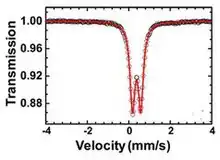 | |
| Names | |
|---|---|
| Systematic IUPAC name
iron(3+) ethanedioate (2:3) | |
| Other names
Iron(III) oxalate | |
| Identifiers | |
| |
3D model (JSmol) |
|
| ChemSpider | |
| ECHA InfoCard | 100.019.047 |
| EC Number |
|
PubChem CID |
|
| UNII | |
CompTox Dashboard (EPA) |
|
| |
| |
| Properties | |
| C6Fe2O12 | |
| Molar mass | 375.747 g/mol |
| Appearance | Pale yellow solid (anhydrous) Lime green solid (hexahydrate) |
| Odor | odorless |
| Melting point | 365.1 °C (689.2 °F) |
| slightly soluble | |
Except where otherwise noted, data are given for materials in their standard state (at 25 °C [77 °F], 100 kPa).
Infobox references | |
Ferric oxalate, also known as iron(III) oxalate, is a inorganic compound composed of ferric ions and oxalate ligands. It is a coordination polymer. The anhydrous material is pale yellow; however, it may be hydrated to form several hydrates, such as potassium ferrioxalate, or Fe2(C2O4)3 · 6 H2O, which is bright green in colour.
Structure
Tetrahydrate
3hydrate.jpg.webp)

According to X-ray crystallography of the tetrahydrate Fe2(C2O4)3 · 4 H2O, iron is octahedral. The oxalate ligand]]s are bridging. Some through all four oxygen atoms, some with two oxygen atoms. Half of the water is lattice water, being situated between chains of Fe oxalates. Mössbauer spectrum of Fe2(C2O4)3 · 4 H2O exhibits an isomer shift of 0.38 mm/s and a quadrupole splitting of 0.40 mm/s, suggesting a high spin Fe3+ in octahedral coordination.[1]
Uses
Dentistry
Like many oxalates, ferric oxalate has been investigated as a short-term treatment for dentin hypersensitivity.[2] It is used in certain toothpaste formulations; however, its effectiveness has been questioned.[3]
Photography
Ferric oxalate is used as the light-sensitive element in the Kallitype photographic printing process; and the platinotype process Platinum/Palladium Printing.
Batteries
Ferric oxalate tetrahydrate has been investigated as a possible cheap material for the positive electrode of lithium-iron batteries. It can intercalate lithium ions at an average potential of 3.35 V, and has shown a sustainable capacity of 98 mAh/g.[1]
Organic synthesis
Ferric oxalate hexahydrate is used with sodium borohydride for radical Markovnikov hydrofunctionalization reactions of alkenes.[4]
See also
A number of other iron oxalates are known:-
References
- 1 2 Ahouari, Hania; Rousse, Gwenaëlle; Rodríguez-Carvajal, Juan; Sougrati, Moulay-Tahar; Saubanère, Matthieu; Courty, Matthieu; Recham, Nadir; Tarascon, Jean-Marie (2015). "Unraveling the Structure of Iron(III) Oxalate Tetrahydrate and Its Reversible Li Insertion Capability". Chemistry of Materials. 27 (5): 1631–1639. doi:10.1021/cm5043149.
- ↑ Gillam, D. G.; Newman, H. N.; Davies, E. H.; Bulman, J. S.; Troullos, E. S.; Curro, F. A. (2004). "Clinical evaluation of ferric oxalate in relieving dentine hypersensitivity". Journal of Oral Rehabilitation. 31 (3): 245–250. doi:10.1046/j.0305-182X.2003.01230.x. PMID 15025657.
- ↑ Cunha-Cruz, J.; Stout, J. R.; Heaton, L. J.; Wataha, J. C. (29 December 2010). "Dentin Hypersensitivity and Oxalates: a Systematic Review". Journal of Dental Research. 90 (3): 304–310. doi:10.1177/0022034510389179. PMC 3144108. PMID 21191127.
- ↑ Barker, Timothy (2001-04-15). "Ferric Oxalate Hexahydrate". Encyclopedia of Reagents for Organic Synthesis (1 ed.). Wiley. pp. 1–4. doi:10.1002/047084289X.rn02346. ISBN 978-0-471-93623-7. S2CID 225482606.